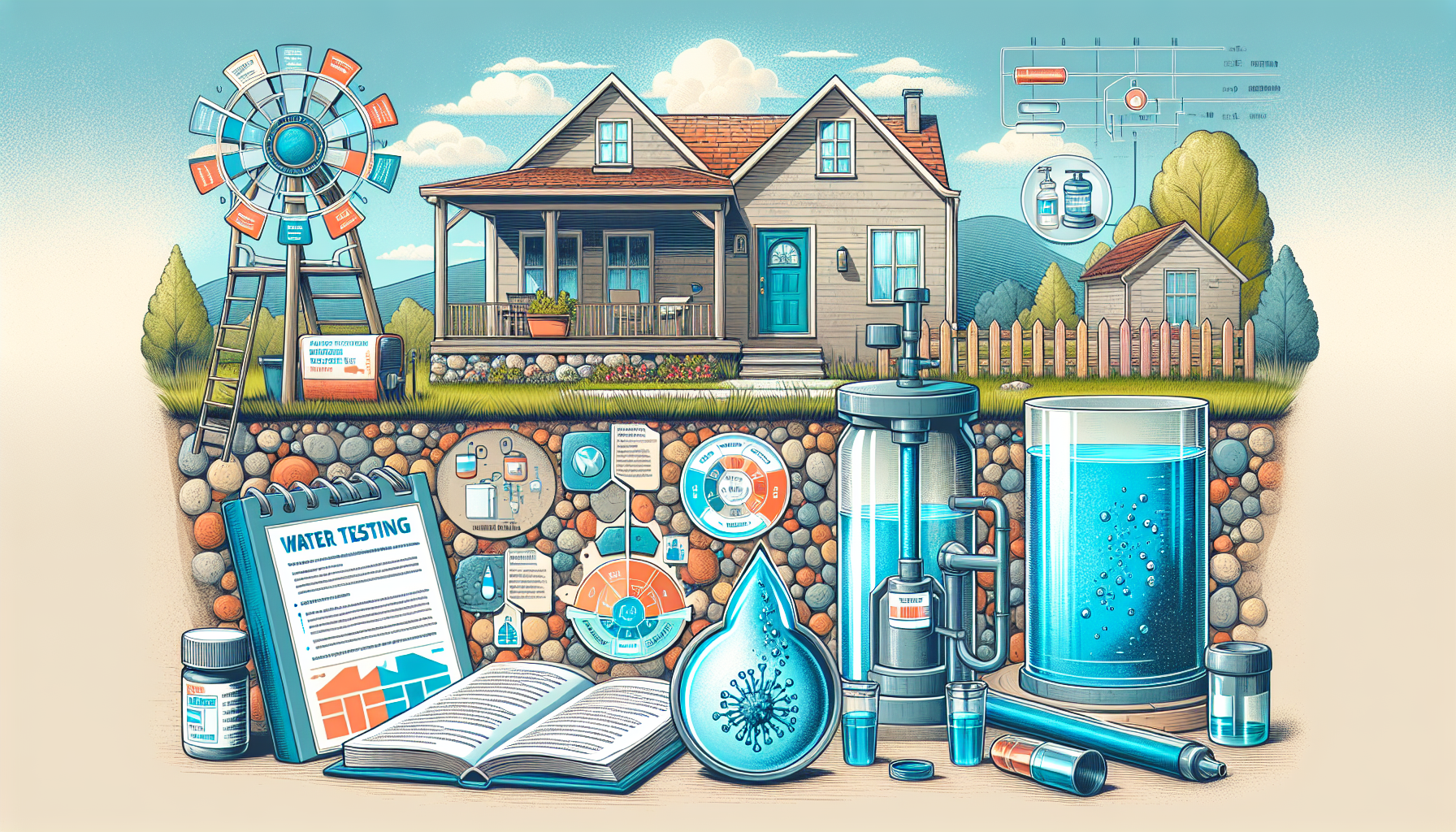Are you a well owner concerned about the vulnerability of your well water system? If so, you might be wondering if there are any resources available to help you assess the situation. Thankfully, there are various sources that can provide valuable information and guidance on evaluating the vulnerability of your well water system. These resources can offer insight into potential risks, provide tips on preventative measures, and even offer advice on how to address any identified vulnerabilities. Whether you are a seasoned well owner or new to the world of well water systems, these resources can help ensure the safety and security of your water supply.

Understanding Well Water System Vulnerability
Introduction to Well Water System Vulnerability
As a well owner, it is important to understand the vulnerability of your well water system. Well water systems can be susceptible to various factors that can compromise the quality and availability of your water. By gaining a better understanding of these vulnerabilities, you can take proactive measures to protect and maintain your well.
Factors Affecting Well Water System Vulnerability
Several factors can contribute to the vulnerability of a well water system. These can include geological and hydrological conditions, well construction and components, local environmental factors, and human activities. Each of these factors can impact the overall integrity and performance of your well, thereby affecting the quality and quantity of your water supply.
Importance of Assessing Well Water System Vulnerability
Assessing the vulnerability of your well water system is crucial for several reasons. Firstly, it helps you identify potential risks and threats that could compromise the safety and reliability of your water supply. Secondly, it allows you to make informed decisions regarding maintenance, repairs, and upgrades to ensure the longevity of your well. Lastly, understanding the vulnerabilities can help you implement appropriate strategies to protect your well water from contamination and mitigate potential risks.
Common Challenges Faced by Well Owners
Water Contamination Risks
Water contamination is a significant concern for well owners. Various sources, such as agricultural run-off, industrial pollutants, and household chemicals, can contaminate the groundwater and seep into your well. Contaminated water poses risks to human health and can lead to illnesses. Assessing the vulnerability of your well water system can help identify potential contaminant sources and implement preventive measures to mitigate these risks.
Deterioration of Well Components
Over time, the components of a well can deteriorate due to various factors such as age, water chemistry, and usage. Ongoing deterioration can impact the efficiency and reliability of your well. Assessing the vulnerability of your well water system allows you to identify signs of component deterioration and take timely action to repair or replace these components, ensuring the optimal functioning of your well.
Decreased Water Availability
Water scarcity is a growing concern in many regions, and well owners may also face challenges regarding decreased water availability. Factors such as droughts, increased water demand, and overuse of groundwater can contribute to reduced water levels in wells. Assessing the vulnerability of your well water system helps you understand the risks of water scarcity and enables you to adopt water conservation measures and explore alternative water sources if necessary.
Testing and Monitoring Well Water Quality
Types of Water Quality Tests
Regular testing and monitoring of your well water quality are essential for ensuring its safety. Different types of tests can be conducted to assess various parameters such as bacteria, chemicals, minerals, and pH levels. Common tests include bacteriological analysis, testing for nitrates and other contaminants, and assessing the overall mineral content. By performing these tests, you can stay informed about the quality of your well water and address any potential issues promptly.
Frequency of Testing
The frequency of testing your well water depends on several factors, including local regulations, well characteristics, and usage patterns. Generally, experts recommend testing your water at least once a year for bacteria, nitrates, and other contaminants. However, if you notice any changes in the color, taste, or odor of your water, it is advisable to conduct additional tests. Understanding the vulnerability of your well water system can help determine the appropriate frequency of testing based on specific factors related to your well.
Interpreting Test Results
Interpreting the results of your water quality tests is crucial in understanding the vulnerability of your well water system. Test results provide valuable information about the presence of contaminants, their levels, and any potential health risks associated with them. If test results indicate the presence of contaminants above the acceptable limits, it is essential to take appropriate actions to address the issues. Understanding how to interpret test results can help you make informed decisions regarding treatment, maintenance, and upgrades for your well.
Assessing Well Infrastructure
Checking Well Construction and Components
Assessing the construction and components of your well is an essential step in evaluating its vulnerability. A well inspection can identify potential weaknesses or deficiencies in the well structure, including casing integrity, well depth, pump placement, and sealing. Examining the components, such as the well cap, screen, and pressure tank, can help identify signs of wear, damage, or malfunction that may affect the overall performance of your well.
Identifying Signs of Deterioration
Regular inspection of your well infrastructure allows you to identify signs of deterioration and take necessary actions to address them. Signs of deterioration can include rust, cracks, leaks, or shifting of the casing. Additionally, changes in water pressure, unusual sounds from the pump, or decreased water flow can also indicate potential issues with well components. By promptly identifying and addressing these signs of deterioration, you can prevent further damage and guarantee the reliability of your well water system.
Evaluating Maintenance and Repair Needs
Assessing the vulnerability of your well water system involves evaluating the maintenance and repair needs of your well infrastructure. Regular maintenance, including well cleaning, pump maintenance, and water treatment, can prevent potential issues and prolong the lifespan of your well. Understand the specific maintenance requirements of your well system and address any repair needs promptly to ensure its optimal performance and minimize vulnerability.

Protecting Well Water from Contamination
Understanding Potential Contaminant Sources
To protect your well water from contamination, it is vital to understand the potential sources of contaminants. These can include nearby septic systems, agricultural activities, industrial sites, or hazardous waste disposal areas. By assessing the vulnerability of your well water system, you can identify potential contaminant sources in your vicinity and implement preventive measures to reduce the risk of contamination, such as maintaining appropriate setbacks from potential sources and implementing best management practices.
Implementing Best Management Practices
Implementing best management practices (BMPs) is crucial for safeguarding your well water from contamination. BMPs include actions such as properly disposing of hazardous substances, using organic fertilizers, and avoiding the excessive use of chemicals. By adopting these practices, you can minimize the potential for contamination from everyday activities and contribute to the overall protection of your well water system.
Installing Protective Measures
Installing protective measures can further enhance the vulnerability of your well water system. These measures can include constructing a protective barrier around your well, such as a concrete pad or well house. Additionally, installing a well cap or seal can prevent surface water runoff from entering your well. By taking these precautionary measures, you can reduce the risk of contamination and protect the integrity of your well water system.
Well Water System Vulnerability Assessment Tools
Online Resources and Databases
Online resources and databases provide valuable information and tools to assess the vulnerability of your well water system. Various websites offer guidance on well water testing, maintenance practices, and information on potential sources of contamination. Online databases can provide access to local geological and hydrological data, helping you better understand the specific vulnerabilities of your well in relation to the surrounding environment.
State and Local Agency Assistance
State and local agencies often provide assistance to well owners, including resources for well water system vulnerability assessment. These agencies can offer guidance on testing protocols, well maintenance, and potential sources of contamination. They may also provide access to professionals who can conduct well inspections and offer expertise in assessing and addressing the vulnerabilities of your well water system.
Professional Well Inspections
Engaging a professional well inspector can provide an in-depth assessment of the vulnerability of your well water system. Well inspectors possess the knowledge and expertise to identify potential risks and weaknesses in your well infrastructure. They can conduct comprehensive inspections, perform water quality tests, and provide recommendations for maintenance, repairs, or upgrades specific to your well. Professional well inspections are a valuable tool for well owners seeking a thorough evaluation of their well water system.

Well Owner Education and Training
Certification Programs for Well Owners
Certification programs for well owners can provide valuable education and training on maintaining and managing a well water system. These programs often cover topics such as well construction, water quality testing, maintenance practices, and well water system vulnerability. By participating in certification programs, well owners can gain the necessary knowledge and skills to effectively assess and address the vulnerabilities of their well.
Workshops and Webinars
Workshops and webinars offer well owners an opportunity to learn from experts in the field of well water systems. These educational events cover a wide range of topics, including well maintenance, water quality testing, and strategies for protecting well water from contamination. Participating in workshops and webinars allows well owners to stay updated on best practices and emerging trends in well water system vulnerability assessment.
Informational Guides and Publications
Numerous informational guides and publications are available to well owners, providing comprehensive information on various aspects of well water systems. These resources cover topics such as well construction, water testing protocols, common vulnerabilities, and preventative measures. By referring to these guides and publications, well owners can gain a deeper understanding of their well water system’s vulnerabilities and learn effective strategies to protect and maintain their well.
Financial Assistance Programs for Well Owners
Grant and Loan Programs
Financial assistance programs, such as grants and loans, are available to assist well owners in addressing vulnerabilities and making necessary upgrades or repairs. These programs can provide funding for initiatives related to well water testing, well infrastructure improvements, and the installation of protective measures. Well owners should explore available grant and loan programs through local organizations, government agencies, and non-profit entities to determine eligibility and access financial support for their well water system.
Tax Incentives and Rebates
Tax incentives and rebates can also help offset the cost of improving the resilience of well water systems. Depending on local regulations, well owners may be eligible for tax incentives or rebates when implementing specific measures to protect their well water from contamination or enhance its efficiency. Investigating potential tax incentives and rebates can provide financial relief for well owners looking to invest in the vulnerability assessment and improvement of their well water system.
Well Upgrade and Repair Funds
Certain organizations and initiatives offer dedicated funds to support well owners in upgrading and repairing their well water systems. These funds can be utilized to address specific vulnerabilities identified through assessments or inspections. Well owners should explore options for well upgrade and repair funds available through non-profit organizations, local agencies, or community partnerships to secure financial assistance for necessary improvements to their well water system.

Working with Professionals and Contractors
Choosing a Qualified Well Contractor
When seeking professional assistance for your well water system, it is essential to choose a qualified well contractor. A qualified well contractor possesses the necessary expertise, licensing, and certifications to conduct inspections, repairs, and upgrades on well systems. Well owners should research and select a well contractor with a proven track record and positive customer feedback. Choosing a qualified well contractor ensures that your well is in capable hands and that any vulnerabilities are effectively addressed.
Collaborating with Environmental Consultants
In complex cases or when dealing with specific vulnerabilities, well owners may benefit from collaborating with environmental consultants. Environmental consultants specialize in assessing the environmental impacts and vulnerabilities associated with well water systems. They can provide expert advice on risk assessment, water quality monitoring, and the development of comprehensive management plans. Collaborating with environmental consultants can offer well owners a holistic approach to understanding and mitigating the vulnerabilities of their well water system.
Understanding Contracts and Agreements
When engaging professionals or contractors for well-related services, it is crucial to understand the contracts and agreements involved. Well owners should carefully review contract terms, including scope of work, deliverables, timelines, and payment schedules. Understanding these contracts ensures that both parties are clear about the expectations and obligations throughout the assessment and improvement process. Consulting with legal professionals may be beneficial when negotiating and finalizing contracts related to well water system vulnerability assessment.
Well Owner Responsibilities and Best Practices
Regular Maintenance and Inspection
As a well owner, regular maintenance and inspection are your responsibilities to ensure the resilience of your well water system. Implementing a routine maintenance schedule, including well cleaning, pump maintenance, and water quality testing, allows you to identify vulnerabilities and address potential issues promptly. Regular inspections help prevent deterioration and ensure the overall efficiency and safety of your well.
Water Conservation Measures
Well owners play a vital role in conserving water and mitigating the risks of decreased water availability. Implementing water conservation measures, such as fixing leaks, installing water-efficient fixtures, and practicing responsible water usage, can help sustain the water supply and reduce the strain on your well. By actively participating in water conservation efforts, well owners contribute to maintaining the resilience of their well water system and supporting overall sustainability.
Community Engagement and Advocacy
Engaging with your local community and advocating for well water system resilience can drive awareness and collective action. Participating in community initiatives, sharing knowledge and experiences, and collaborating with local organizations can create a network of support for well owners. By advocating for the protection of groundwater resources and promoting well water system vulnerability assessment, well owners can contribute to the development of proactive measures and policies that benefit the entire community.
In conclusion, understanding the vulnerability of your well water system is crucial for every well owner. By assessing potential risks, regularly testing and monitoring water quality, evaluating well infrastructure, and implementing protective measures, you can ensure the safety, reliability, and longevity of your well water system. Utilizing available resources such as online tools, state and local agency assistance, educational programs, and financial assistance programs can further support the assessment and improvement of your well water system’s vulnerabilities. As a responsible well owner, it is essential to fulfill your responsibilities, practice best management practices, and actively engage with professionals, contractors, and the community to protect your well and advocate for the resilience of well water systems.


